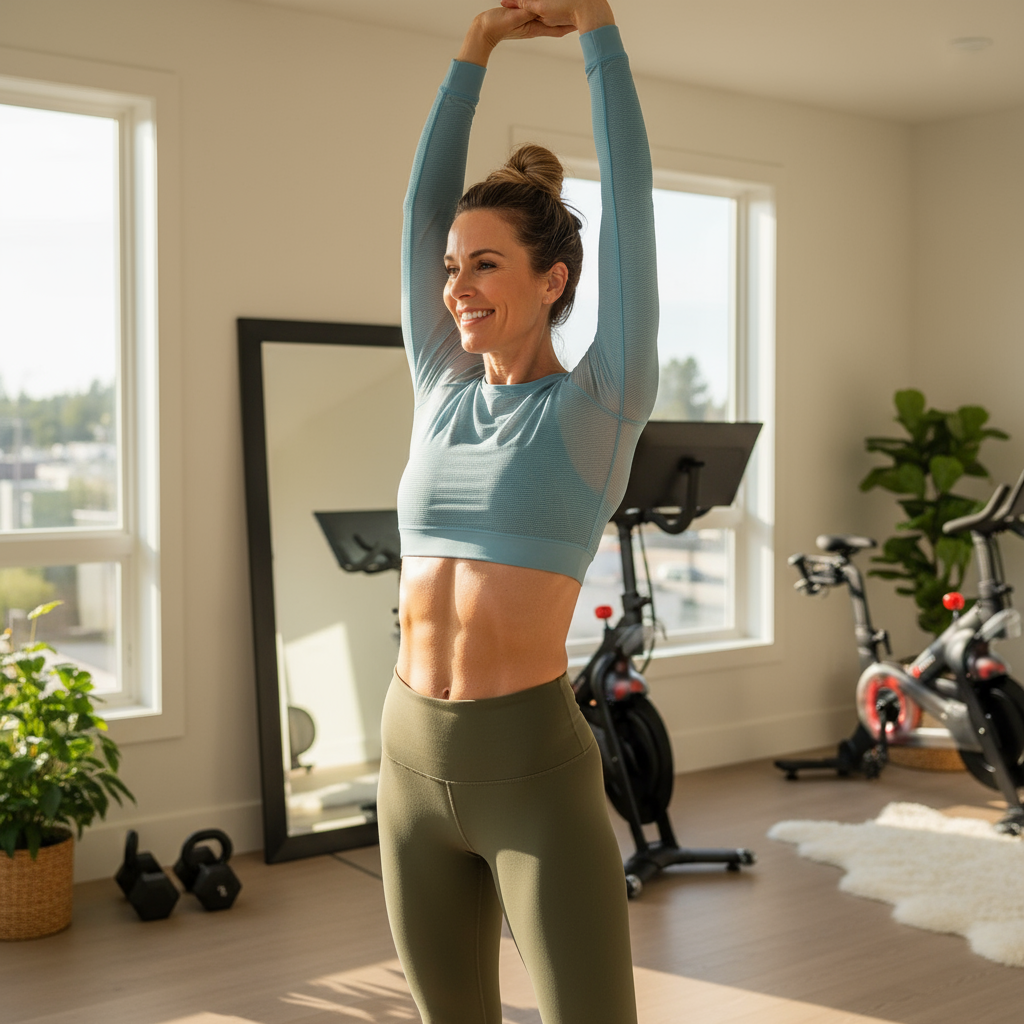
Table of Contents
Introduction
So you’ve hit 40, and suddenly your body feels… different. Maybe you’re noticing that your metabolism isn’t quite what it used to be, or perhaps you’re feeling less strong than you did in your thirties. Here’s the thing—you’re not imagining it. But before you start thinking your best fitness days are behind you, let me stop you right there. Building muscle after 40? Not only totally doable, but it might be one of the smartest things you can do for your health.
Let’s talk about what’s really happening in your body. There’s this thing called sarcopenia—basically, the natural loss of muscle mass as we age. Sounds scary, right? It doesn’t have to be. Your body is just asking for a different approach now. That’s where functional fitness workouts come in clutch. These aren’t your typical gym routines—they focus on movements that actually matter in daily life. Think strength, balance, and mobility all rolled into one. And if you’re just getting started? Don’t worry. There are plenty of fitness challenges designed for beginners that won’t leave you feeling defeated on day two.
Now, here’s where things get interesting. Building muscle after 40 isn’t just about looking good (though that’s a nice bonus). It’s about managing your weight as your metabolism decides to slow down—thanks a lot, biology. The good news? Combining smart fitness tips for weight loss with strength training can work wonders. You’ll want to mix in some cardio too, and cardio workouts for fat burning can boost your heart health while supporting those muscle gains. Pro tip: if you’re short on time (and who isn’t?), check out kettlebell workouts. They’re like the Swiss Army knife of fitness—strength, cardio, and flexibility all in one efficient package.
But wait—there’s more to this puzzle. (And it’s a big piece.) Nutrition becomes absolutely critical when you’re building muscle in your 40s. Your body needs the right fuel, and that means understanding nutrition for building muscle mass and nailing your protein intake for muscle building. Think of protein as your muscles’ best friend—they literally can’t grow without it. And while we’re talking nutrition, don’t sleep on foods like kale that fight inflammation and speed up recovery. A high protein diet isn’t just trendy—it’s essential for muscle synthesis. Plus, learning how to improve insulin sensitivity can help your body actually use all those nutrients efficiently.
What You’ll Learn in This Guide
Ready to dive in? This guide covers everything you need to know about building muscle after 40, and I mean everything. Here’s what we’re covering:
- Understanding Muscle Changes: Learn about physiological changes affecting muscle mass and metabolism after 40 and why resistance training becomes critical.
- Effective Workout Plans: Discover strength training principles, cardio routines, and flexibility exercises suited to your needs and goals.
- Nutrition Essentials: Explore tailored nutrition advice, focusing on protein, vital micronutrients, and meal timing for optimal muscle development.
- Injury Prevention and Recovery: Understand common injury risks and learn recovery techniques like foam rolling and rest strategies to stay safe and perform better.
Speaking of workouts, we’ll walk through exactly how to start a fitness routine that actually sticks. Because let’s be honest—starting is one thing, but consistency? That’s where the magic happens. And if you’ve got a partner who’s game, fitness challenges for couples can be a game-changer. There’s something powerful about having someone in your corner, cheering you on (and making sure you show up on those days when motivation is running low).
Here’s something that becomes even more important as we age: injury prevention. Trust me, a pulled muscle in your 40s doesn’t heal like it did in your 20s. That’s why practices like foam rolling for mobility and muscle pain relief aren’t just nice-to-haves—they’re essentials. And don’t forget about your core. Strong core muscles are like your body’s natural weight belt, protecting your spine and improving your posture for safer, more effective workouts.
Now, here’s something people don’t talk about enough: your mindset matters. A lot. The mental game can make or break your fitness journey, especially when you’re dealing with the unique challenges that come with being over 40. That’s where techniques like mindfulness meditation and yoga for mental health can be total game-changers. They help manage stress, sharpen your focus, and improve recovery—all while keeping you motivated for the long haul.
Look, building muscle after 40 isn’t about turning back the clock or trying to compete with your 25-year-old self. It’s about working with your body as it is now and giving it what it needs to thrive. With the right approach to training, nutrition, recovery, and mindset, you can absolutely build the strong, healthy body you want. Ready to prove that your best years are still ahead of you? Let’s get started!

Introduction
Let’s talk about something most people don’t want to face: building muscle after 40 isn’t the same as it was in your twenties. Your body’s changing—that’s just reality. But here’s what might surprise you: this can actually be one of the most rewarding times to focus on your strength. Sure, you’re dealing with slower recovery and shifting hormones, but you’re also armed with something your younger self didn’t have—wisdom, patience, and a real understanding of why this matters. We’re going to walk through exactly what’s happening in your body right now and, more importantly, what you can do about it. Think of this as your roadmap for staying strong, mobile, and independent for decades to come.
Understanding Muscle Changes After 40
Here’s the thing nobody tells you about hitting your forties—your muscles start playing by different rules. That gradual loss of strength you might be noticing? It has a name: sarcopenia. Sounds scary, but it’s just your body’s way of saying “use it or lose it” gets more serious with age. Your metabolism decides to take a coffee break right around this time too, thanks to dropping testosterone and growth hormone levels. (Mother Nature clearly has a sense of humor.)
But before you start feeling defeated, consider this: every challenge here is also an opportunity. Building muscle after 40 isn’t just about looking good—it’s about staying functional. We’re talking about being able to carry your groceries, play with your kids or grandkids, and yes, even rearrange furniture without throwing out your back. Plus, stronger muscles mean stronger bones, better balance, and a metabolism that actually works for you instead of against you. If you’re wondering where to start with the basics, checking out best strength training exercises can give you a solid foundation to build on.
Key Aspects of Muscle Changes After 40
Let’s break down what’s really happening so you can work with your body, not against it:
- Decreased Muscle Mass and Strength (Sarcopenia): Your muscle fibers are literally shrinking and disappearing—roughly 3-8% per decade after 30. This affects everything from your balance to your injury risk. The good news? Resistance training can actually reverse this process by stimulating new muscle growth.
- Slower Metabolism and Hormonal Shifts: Your metabolic rate drops, and those muscle-building hormones aren’t flowing like they used to. It’s frustrating, but it’s not game over. Smart training and nutrition can work around these changes more effectively than you might think.
- Improved Mobility and Health Outcomes: Here’s where it gets interesting—building muscle at this stage doesn’t just make you stronger, it makes you move better. Better joint support means less pain and more confidence in your daily activities.
- Support for Weight Management and Bone Density: Muscle tissue is metabolically expensive—it burns calories even when you’re sitting on the couch. And when you lift weights, you’re not just building muscle; you’re telling your bones to get stronger too. It’s like a two-for-one deal your body can’t refuse.
Now that you understand what you’re working with, let’s talk about how to make it work for you.
Effective Workout Strategies for Building Muscle After 40
Forget what you did in your twenties—this is about working smarter, not just harder. The secret sauce? Compound movements that give you the biggest bang for your buck. We’re talking exercises that work multiple muscle groups at once because, let’s be honest, you probably don’t have three hours a day to spend in the gym. Progressive overload is still your best friend (gradually adding weight or reps), but now recovery becomes just as important as the workout itself.
Your new mantra should be: lift heavy, rest well, and don’t ignore your heart. Moderate cardio keeps your cardiovascular system happy without interfering with muscle gains. And those flexibility and mobility exercises you used to skip? Yeah, they’re non-negotiable now. Think of them as an insurance policy for your joints. If you’re just getting back into fitness or need some structure, browsing through fitness challenges for beginners can provide the motivation and progression you need to stay consistent.
Key Aspects of Effective Workout Strategies
Here’s your game plan for building muscle efficiently and safely:
- Compound Movements for Efficiency: Squats, deadlifts, and bench presses aren’t just gym classics—they’re efficiency powerhouses. These exercises work multiple muscle groups simultaneously, giving you maximum results in minimum time. Perfect for busy schedules.
- Progressive Overload: This is where the magic happens. Gradually increasing your weights or reps keeps your muscles guessing and growing. Track your progress—it’s incredibly motivating to see those numbers climb week after week.
- Recovery and Rest: Your twenties-era approach to recovery (what recovery?) won’t cut it anymore. Plan rest days like you plan workouts, prioritize sleep like your gains depend on it (because they do), and consider techniques like foam rolling to keep your muscles happy between sessions.
- Cardio and Flexibility Integration: Think of cardio as your heart’s strength training and flexibility work as your joint maintenance program. Moderate cardio supports fat loss without eating into your muscle gains, while regular stretching keeps you moving like a human, not a robot.

So here we are—you’ve just learned everything you need to know about building muscle after 40. And honestly? It’s pretty exciting stuff. Sure, your body throws some curveballs as you age. Sarcopenia, slower metabolism, hormonal changes—they’re all real challenges. But here’s what I want you to remember: these changes actually make muscle building more important, not less. Strong muscles aren’t just about looking good (though that’s a nice bonus). They’re your ticket to staying mobile, protecting your bones, managing your weight, and feeling vibrant for years to come. That’s what real longevity looks like.
We’ve covered a lot of ground together. Smart workout strategies that actually work for your body now—compound movements that give you the biggest bang for your buck, progressive overload that challenges you safely, and recovery time that your muscles desperately need. Add some moderate cardio and flexibility work, and you’ve got a recipe for success. Then there’s nutrition—your secret weapon. Getting enough protein isn’t negotiable, and those vitamins D and B12? Think of them as your muscle-building sidekicks. Don’t forget about recovery techniques like foam rolling and quality sleep. Trust me, your 40-something body will thank you for the extra TLC.
Ready to put this into action? Great—because knowledge without action is just interesting trivia. If you’re just getting started (or making a comeback), check out our guide on how to start a fitness routine that’s actually designed for your age. No more following workout plans meant for 20-year-olds. Once you’ve got the basics down, dive into our resource on best strength training exercises—these compound movements are game-changers for building real strength after 40. And if you’re worried about staying motivated? Join some fitness challenges for beginners. There’s nothing like a supportive community to keep you showing up.
Now let’s talk nutrition—because you can’t out-train a bad diet. Our guide on nutrition for building muscle mass breaks down exactly what your body needs: how much protein, when to eat it, and which nutrients will supercharge your results. No guesswork, just science-backed strategies that work.
Here’s the bottom line: building muscle after 40 isn’t about trying to turn back the clock. It’s about working with your body as it is right now. Exercise, nutrition, recovery, mindset—they all matter. Every workout makes you stronger. Every good meal fuels your progress. Every night of quality sleep helps you recover. And every small win? Celebrate it. Your body is incredibly adaptable, even now. Maybe especially now. You’ve got everything you need to succeed, so why wait? Start today.
Frequently Asked Questions
-
Is it too late to start building muscle after 40?
- No, it is possible and beneficial to start muscle building at any age with the right approach.
-
How often should I work out to build muscle after 40?
- Typically, 3-4 strength training sessions per week with rest days in between are recommended.
-
What are the best foods to eat for muscle growth after 40?
- Lean proteins, healthy fats, complex carbohydrates, and adequate hydration.
-
Can I prevent muscle loss as I age?
- Regular strength training and proper nutrition can significantly slow muscle loss.
-
When should I see a doctor about muscle building?
- If experiencing chronic pain, injury, or underlying health conditions, consult a healthcare professional.
